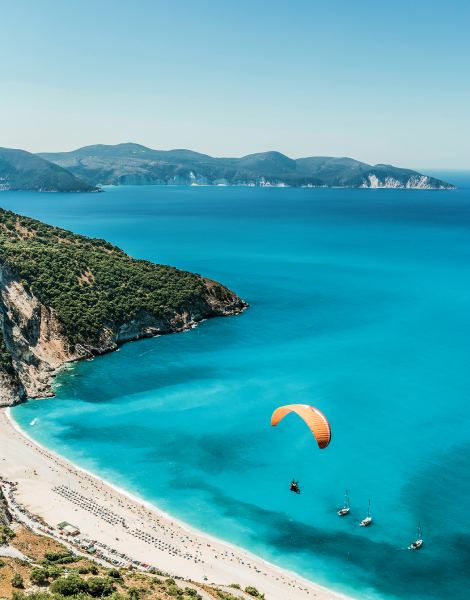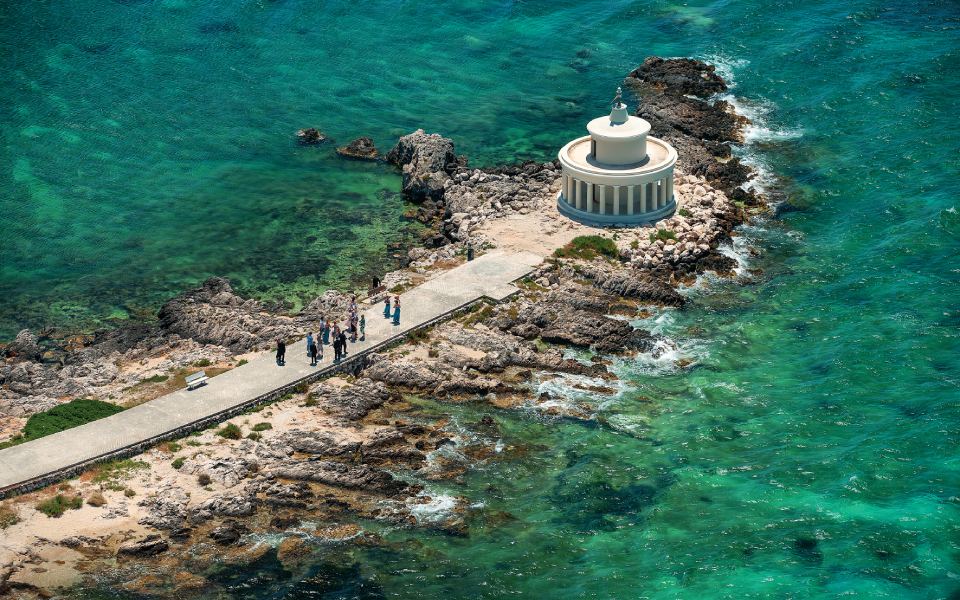My journey starts in Sami, not only because it is my hometown – which means it holds a special place in my heart – but also because it’s one of the island’s most important towns, with a history that stretches back into antiquity. Kefalonia’s main port, Sami is an ideal base from which to start exploring the island. Two unique destinations lie close at hand: the Drogarati Cave, with its golden stalagmites and stalactites and acoustics that would be the envy of the Hamburg Philharmonic; and the Lake Cavern of Melissani at Karavomilos, where the waters take on a psychedelic iridescent appearance under the noon sun.
The star of the region, however, is Antisamos, a magical beach with deep waters surrounded by green hills. If you want to get a sense of what Kefalonian villages used to look like, head up to deserted Palia Vlachata, where every summer, apart from this year, the Saristra music and art festival takes place amidst picturesque ruins.

© Perikles Merakos
My favorite stretch of road on the island starts at Karavomilos and extends northwards. It is 7km long and runs alongside the shoreline just 5-6 meters above sea level; its successive turns follow the serpentine coastline which is full of small coves, all lined with olive trees and dense vegetation. The only beach with amenities in the area is Aghia Paraskevi, but I prefer Psamousa, which is like a private swimming pool ringed by rocks; if you’re lucky enough to find space, you’ll never want to leave. Next is Aghia Effimia, an elegant village by the sea with a small harbor filled with sailboats; at the edge of town is Piso Lithovati Beach. If you’re feeling hungry, the family taverna Paradisenia Akti, known to locals as Dendrinos, serves fish and a variety of traditional selections. If there’s any bakaliaros (cod) pie left, don’t hesitate to order some.
If you’re continuing north from here, you have two options: you can either take the road that runs along the eastern side of Kefalonia, with views over Ithaki, or you can pick the western road, which runs above Myrtos Bay and the village of Assos.
If you choose the western route, you’ll go through the central square of the village of Makryotika, where Petraggelos Vagianatos at the taverna Maklithari serves a fiery local garlic dip and meat pie like my mother makes it. Everybody knows Myrtos Beach, which repeatedly features on lists of the world’s best beaches. The thing to do here is to sit on this beach until the sun starts setting and then dive into the water at the same time the sun does – a ritual that we reverently observe at least once every summer.

© Dionysis Kouris

© Dionysis Kouris
After Myrtos, the road carries on to the northern part of the island, revealing an astounding series of cliffs and endless blue vistas, before it reaches the Assos peninsula where you’ll find the village of the same name. Assos resembles the villages of the Amalfi Coast. It has an impressive Venetian castle which is home to a large variety of cicadas that produce an exceptionally loud sound. With its handful of colorful houses with flower-filled gardens and whitewashed courtyards, a handful of tavernas, no large hotels, and no bars, Assos is like something out of a romance novel, a simple place where time flows quietly and smoothly.
Continuing north, you’ll encounter the small villages of northern Kefalonia. Turn left at Magganos and head towards the beaches of Alaties and Aghia Ierousalim. Alaties is a small beach that’s covered in white pebbles and surrounded by rocks on each side; its waters are turquoise. Aghia Ierousalim extends along two bays and has a small ruined church. Here, you’ll find the eatery Odysseas, one of the island’s best tavernas. And now let’s move on to the hidden secrets – which have yet to succumb to mass invasions although they have been whispered about quite a lot: Dafnoudi and Kimilia, two incredible beaches that can be accessed via paths. They both have blinding white pebbles, crystal-clear turquoise waters, caves, rocks to jump from and zero organized facilities.

© Giannis Giannelos
Near the northernmost part of the island, the road turns eastward to Fiskardo, one of the Mediterranean’s most cosmopolitan places, with luxury yachts docked in its harbor. Resisting the temptation to sacrifice aesthetics for profit, this seaside village remains free of large hotels. Here, the landscape imposes its own terms. Walk to Panormo Bay, or head further south and take a dip at Foki Beach, where tall cypresses and age-old olive trees form a fabulous natural art installation.
If on your journey north from Aghia Effimia to Fiskardo you’ve decided to follow the eastern road, you’ll cross one of the island’s wildest regions, dotted with age-old villages, their gaze fixed on the island of Ithaki across the water. On this route, you’ll discover fantastic beaches tucked away in places that tourism hasn’t found yet. Giagana is a secret bay below Neochori, with shiny white pebbles, green waters, and shade provided by olive trees that grow right to the water’s edge. The marvelous beach of Horgota will take your breath away with its beauty as you head towards it down a winding road. Aghia Sofia Beach features the ruins of old abandoned houses standing right on the shore – like a set for an Italian neorealist movie. If you’re feeling adventurous, take the dirt road from the village of Mesovounia, park at the end and take a narrow path for 15 minutes until you reach Katalymata Beach. A bit further north, and accessible by dirt road, is Kamini, an astonishing beach with blue-green waters which you’re likely to find deserted even at the height of the season.

© Dionysis Kouris
ON THE SOUTHERN COASTLINE
The island is different down here. First of all, there’s Mt Ainos, an imposing mass covered in fir trees. The highest mountain in all of the Ionian islands reaching 1,628 meters, it’s located in the national park that bears its name. At the foot of the mountain lies the island’s southern coastline, with its long sandy beaches, some inaccessible and others, like Makris Gialos, sadly overcrowded. Paradisi, an exotic and slightly remote beach located below the ruins of the Sissia Monastery, is a well-kept local secret. Sissia is one of the island’s oldest monasteries; according to tradition, it was founded by St Francis of Assisi. Koroni, another fantastic beach on the eastern coast, is a breeding ground for the Caretta caretta, the loggerhead sea turtle. On the path leading to Koroni stands Koroni Hill Bar Sesto, one of my favorite snack bars in Greece. It offers excellent local tsipouro (a strong spirit) and a magical view. From here, the main road south leads to Skala, the island’s most touristic spot but one with a beautiful large beach, before it turns towards the eastern coastline of southern Kefalonia, running north up to the port of Poros.
EXOTIC AND REMOTE BEACHES
The long string of beaches after Aghia Kyriaki can only be reached by sea, such as by speedboat from the small harbor at Zola. The first is Kamari, with impressive caves and a turquoise hue to the surrounding waters. Fteri, one of the best “unknown” beaches in Greece, is covered in off-white pebbles; seen from above, it looks like an exotic islet somewhere in Polynesia. Further west, the coastline features strips of sand under limestone cliffs all the way to Amidi, my favorite beach. After your swim, stop for some fish at Kalyva tou Psara, on the harbor of Aghia Kyriaki. It only serves fish caught by its owner on his own fishing boat.

© Dionyssis Kouris
THE PALIKI PENINSULA
Welcome to Lixouri, a reflection of old Kefalonia and the main town on a peninsula of raw beauty. Here, you’ll travel back in time through beautiful little villages and settlements such as Kontogennada, Damoulianata, Monopolata, Kaminarata, and Havdata. There are, of course, more cosmopolitan places on the peninsula, like the beach of Xi with its gray clay-like stones. Those in the know will soak pieces of those stones in seawater and then rub them on their bodies in a form of mud therapy. Petani Beach is a replica of Myrtos, with incredible colors underwater. In Porto Athera, a settlement straight out of another era that’s spread around a narrow bay, the key landmark is Greek composer Linos Kokotos’ “Blue House”, today protected as a historic building. At the center of the beach lies the Drosos taverna where you’ll enjoy exceptional fish and jazz music.
A STROLL AROUND TOWN
Following the massive destruction wrought by the 1953 earthquake, Argostoli underwent a long and difficult period of rebuilding. However, the island’s capital is now back, upgraded, offering romantic walks on the De Bosset Bridge at sunset, and strolls down the cobbled streets of the center. Peruse the Focas-Cosmetatos Foundation’s great collection of paintings, lithographs and coins, and visit the Historical and Folklore Museum. The city’s botanical gardens, the only one in the Ionian islands, covers an area of 2.8 hectares and features a lake and an open-air theater.












